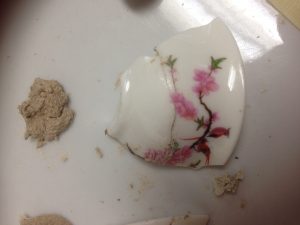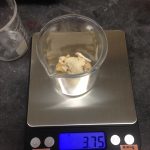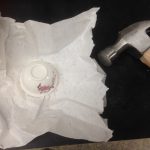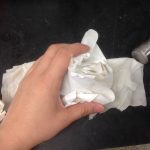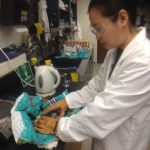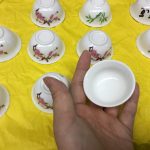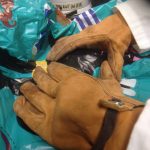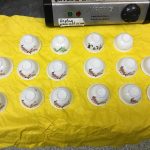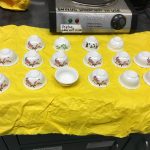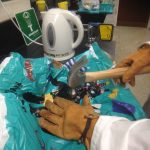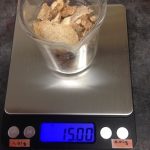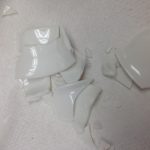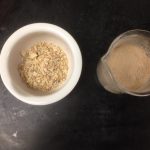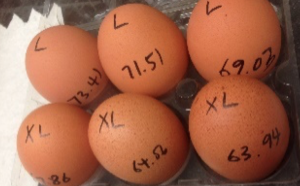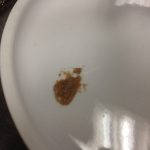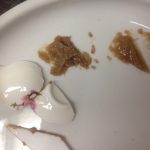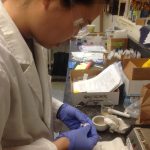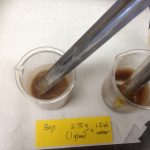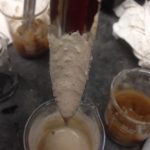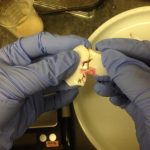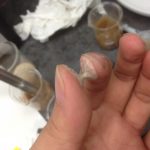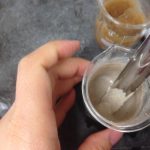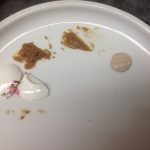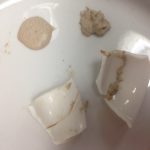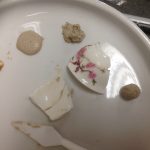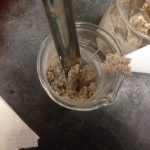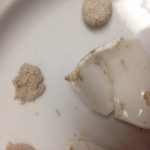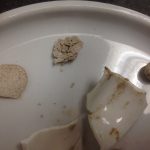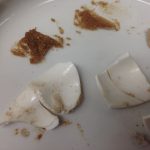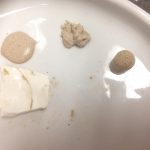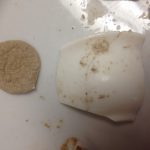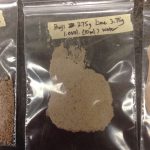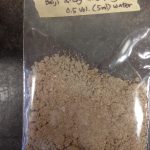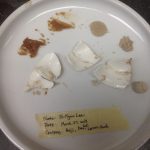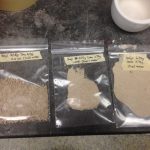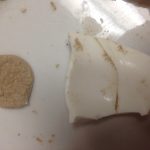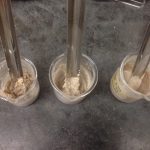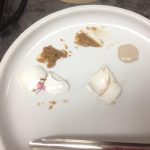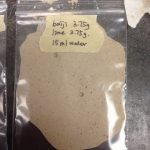by Ji-Hyun Lee
Material Analysis
Recipes 1, 3 & 6 in Imwon kyŏngje chi 林園經濟志 (Encyclopedia of rural life management)
Following the measurement of the egg whites and processing it to perfect liquid, recipes 1, 3, and 6 are to be tested for the day:
1) 先將瓷碗烘熱, 用鷄子清調石灰補之, 甚牢.
First, heat the ceramic bowl in fire, use the clear part of an egg mixed with lime to repair it. Extremely durable.
–“王氏農書”
(actually found in 農政全書 卷42, 製造)
(Ming dynasty)
3) 白芨一兩爲末, 鷄子清調勻修補, 以線札緊, 火上烘乾, 如新永不壞. 忌用鷄湯洗.
Evenly mix 1 liang of baiji (Bletilla striata Reichenbach fil.) made into powder and clear part of egg to repair. Tighten with strings and pieces of wood, dry on top of fire. It will ever last undamaged. Do not use for washing with chicken stock.
–古今秘苑 卷4, 粘磁器法 (Qing dynasty)
6) 鷄子白和白礬末, 粘之妙.
Mix egg white and alum powder, and finely glue.
–增補山林經濟 卷16, 雜方, 粘磁器方 Miscellaneous methods, Fascicle 16, Supplemented Management of Forest and Lands (1766, Chosŏn)
Source:
Dry baiji slices, 100g (purchased at Kamwo Meridian Herbs, 211 Grand Street, NY10013)
Lime powder (Calcium carbonate, Amazon.com)
Prior knowledge observation before experiment:
Baiji: Rhizome of Bletilla striata Reichenbach fil., a southern Chinese orchid. Usually steam-dried for medical use. Bitter and sweet taste. Cool. Works on the meridian of lung to invigorate lung. Often used to treat lung disease, stop bleeding and treat metal cuts.
Lime powder: The recipe did not distinguish whether the lime is calcium carbonate, calcium hydroxide, or calcium oxide.
FIELD NOTES
Date: March 08, 2018
People Involved: Ji-Hyun Lee (Naomi Rosenkranz)
Location: 260 Havemeyer
Environmental Conditions
The experiment was conducted at inside Making and Knowing Lab in Columbia University, fully facilitated with measuring tools and equipment for experiment and safety, and in room temperature of 68-71F, and 21% humidity.
Time and duration of experiments
Measuring eggs and beating egg white… 1hr (2:00-3:00pm)
Grinding remaining baiji roots … 1hr 10mins (3:00-4:10pm)
Testing proportions and cementing samples … 45mins (4:20-5:05pm)
Equipment and tools used
The same mortar, pestle, and electric coffee grinder from the last experiment were used to powder the remaining mass of baiji slices, the same four glass beakers, measuring spoons, and 0.01g unit balance to measure and mix the ingredients. An additional equipment to remove coarse particles, a ball of fine tea-mesh was purchased.
For handling egg whites, thanks to one of the staff members at the lab, who kindly lent a manual egg-beater to save time beating egg white in a glass container.
Materials and their source and quantities
Two packs of six organic eggs were purchased Fairway Market, in L and XL sizes by mistake, not M and L sizes as initially planned. Three from each package will be used to estimate the average mass of the egg white from a single egg.
The remaining 73g of dried baiji (purchased at Kamwo Meridian Herbs) were prepared for grinding into powder for further experiments.
Subjective factors, e.g., how things smelled/tasted/looked/felt
Baiji by itself looked like a difficult material for making smooth glue not only for the growing size of the particles with added moist, but also because of the amount of fiber pieces yielded following the process of grinding and sieving.
Prior knowledge that you have
Egg whites is one of the binding liquid for tempera. The protein in the liquid is basically prone to decay in a few days even inside the refrigerator, but once dry, it is extremely chemically stable and preserves the pigment colors semi-permanently. The authentic method to process it as binder is to finely beat and completely break it into liquid before use.
Reflection on your practice
Measuring egg whites
Ironically, the large (organic) eggs turned out to be larger and heavier than the X-large (omega-3) eggs! So instead of trying to use the average weight of the egg and the white as the standard amount, the average percentage mass of the egg white per egg was taken and multiplied by the FDA minimum standard weight for an L size egg (56.7g) to set the standard mass of one egg’s white for this experiment.
Measurement
| XL1 | XL2 | XL3 | L1 | L2 | L3 | |
| Egg | 67.86 | 64.56 | 63.94 | 73.41 | 71.51 | 69.03 |
| Y+W | 58.91 | 55.80 | 55.39 | 62.83 | 62.99 | 60.05 |
| W | 41.25 | 37.57 | 37.17 | 44.52 | 46.40 | 43.43 |
| W/E | 60.9% | 58.2% | 58.1% | 60.6% | 64.9% | 62.9% |
Avg. percentage: 61%
Est. egg white per 56.7g egg: 34.59g (35ml)
Egg whites, once finely beaten into foams, would take very long time to subside. The process was too time-consuming that perhaps it may be acceptable to skip this process next time.
Testing proportions for Recipe 3
37.5g baiji + 1 egg white (34.56g) -> x10% -> 3.75g baiji + 3.46g egg white
The density and viscosity of the clay were much higher than equivalent proportion of (baiji+ lime)+water. The overall texture and stickiness was similar to those of oil-based clay or skulpy. Because of the density, it was difficult to apply the mixture to cement on ceramic since the cohesion was much stronger between each dab of clay than on the broken section of the edge.
37.5g baiji + 1.5 egg white (51.84g) -> x10% -> 3.75g baiji + 5.18g egg white
The density was that of soft clay that it spreads with pressure. This proportion was the best among three to keep the porcelain pieces stuck together.
37.5g baiji + 2 egg white (69.12g) -> x10% -> 3.75g baiji + 6.91g egg white
The mixture had a thick cement density and spreads smoothly on plate, but it was overall a failure as adhesive since the pieces fell apart with little finger pressure during the re-assemblage.
Questions that arise: I am not at all convinced that the recipes using baiji may have been actually practiced since the material was overall very difficult to process and handle yet not very effective for the efforts invested into it. Perhaps the Southern Chinese had particular knowhows to process baiji into a better type of glue, for instance, using fresh baiji or other methods that I have not been able to think of.
Date: April 25, 2018
People Involved: Ji-Hyun Lee
Location: Communal Kitchen, I-House
Environmental Conditions
Normal kitchen environment with room temperature and empty worktable space.
Time and duration of experiments
Testing glue and repairing ceramic … 2hrs (3:00-5:00pm)
Break & making packages … l hr (5:00-6:00pm)
Packaging results and cleaning up …30 mins (6:30-7:00pm)
Equipment and tools used
4 small containers with glues, 4 porcelain cups, safety gloves & latex gloves, candle, 2-3 mixing rods (metal chopsticks), 1 swiss army knife (with knife and plier), 1-4 porcelain/paper dishes
Materials and their source and quantities
Four egg-white-based glue samples (lime, baiji, alum 1, alum 2), about 7g each, were self-prepared few hours ago on the same day (April 25, 2018)
Porcelain cups were purchased at Amazon.com Marketplace.
Subjective factors, e.g., how things smelled/tasted/looked/felt
The most difficult part of repairing ceramic was to fit the pieces seamlessly into its original shape ensure the shape stays still through the process rather than using the glue. Below are the overall impressions of the samples and recipes tested.
Prior knowledge that you have
Knowledge from the previous experiment (see fieldnote 3 and attachment for details):
Recipe 1, sample 1 (3.75g lime + 1.73g egg white):
– smooth, lightweight, and chalk-white cement material. The dried cement breaks off when scratched hard using a fingernail.
Recipe 3, sample 1 (3.75g baiji + 3.46g egg white):
– brown, sticky clay with coarse granules and fibers.
Recipe 6, sample 1 (3.75g alum on 3.46g egg white):
– very sticky and slightly foamy sugar-white glue.
Recipe 6, sample 2 (3.75g alum on 1.73g egg white):
– very sticky and slightly foamy, sugar-white paste.
Reflection on your practice
Recipe 1, sample 1 (3.75g lime + 1.73g egg white):
– The mixture sticks and spreads very smoothly on the surface like acrylic gesso or emulsion. The white tone of the cement is most identical to the porcelain body of the cup, expected to return the finest outcome only if finished skillfully. However, the glue was overall quite slippery that it was not easy to stick the pieces into an exact fit.
-> Probably used by professionals rather than normal households. The strength of the fired cement was similar to that of hard plaster that may have been strong enough to hold the pieces together if used with care. Suitable for decorative ceramic that it appears in Ming dynasty agricultural encyclopedia, but riveting probably have taken over in repairing utilitarian vessels by the Qing period.
Recipe 3, sample 1 (3.75g baiji + 3.46g egg white):
– Albeit for the sake of adhesiveness, thick baiji paste is difficult apply on ceramic surfaces and wet granules hindered fitting the pieces perfectly. The glue seemed to work when fitting two fragments only, but when working with additional pieces, the glue did not hold strong enough against multi-directional application of force while assembling the whole cup. Irregular texture caused by wet granules resulted in pores in the paste and probable leakage after repair.
-> not recommendable.
Recipe 6, sample 1 (3.75g alum on 3.46g egg white):
– The easiest material to handle among all samples tested. But the mixture is too sticky that the residues on the surfaces cannot be wiped clean. The dried alum paste had subtle flexibility of hard plastic.
-> The recipe was quoted from a Korean source. Very effective. Likely to have been practiced in real life. Wiping surfaces clean requires another knowhow.
Recipe 6, sample 2 (3.75g alum on 1.73g egg white):
– The glue was not as strong as the 1/2 egg proportion paste, but still was adhesive enough and was convenient that it could be applied thinner, so it was easier to exactly fit the pieces together and wipe the residues on the surface.
Questions that arise:
Which of these recipes might have been widely practiced in Korea for repairing utilitarian ceramic or decorative ones?
